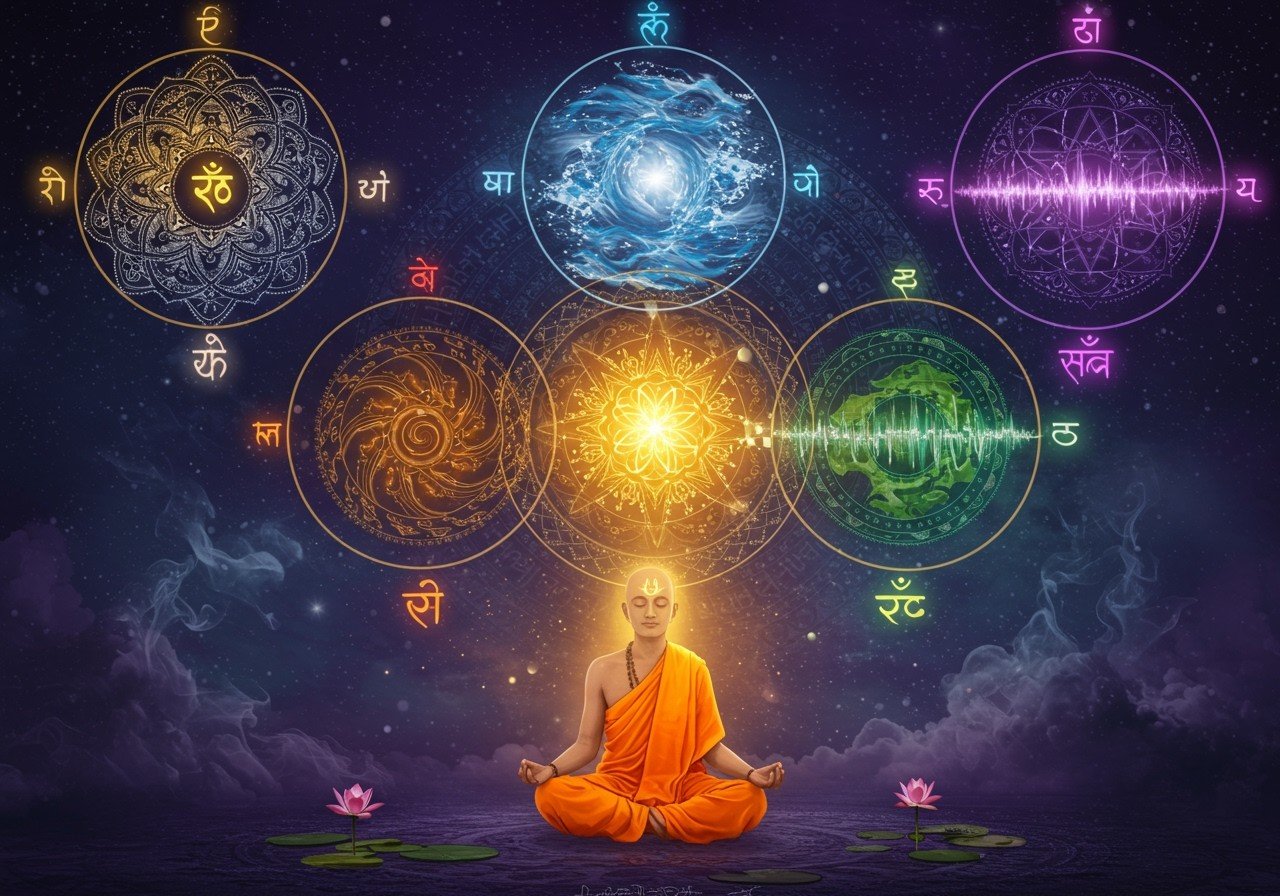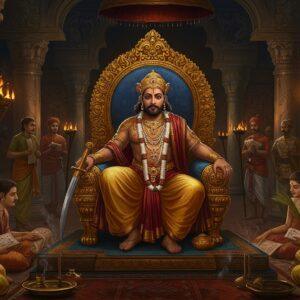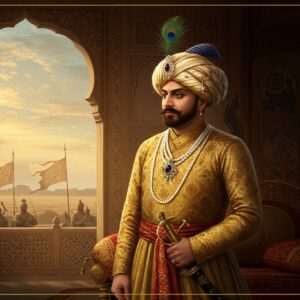
Understanding the profound role of Tanmatras in Hindu philosophy can enrich spiritual practices. These subtle elements form the foundation of sensory experiences and connect the metaphysical with the physical world. For culturally rooted Indians who value tradition, exploring Tanmatras deepens the connection to authentic rituals. You can find a variety of items related to Hindu rituals and practices at Poojn.in.
Tanmatras Meaning and Etymology
Tanmatras is a Sanskrit term meaning “subtle essence” or “element.” Each Tanmatra aligns with one of the five sensory perceptions: sound, touch, form, taste, and smell. Originating from ancient Vedic texts, they play a vital role in Samkhya and Vedanta schools of Hindu philosophy. The term’s linguistic roots in Hindi underscore its cultural importance in everyday spiritual practices.
The Five Tanmatras and Their Corresponding Elements
In the heart of Hindu philosophy lies the concept of Tanmatras, weaving a delicate tapestry with the five elements, or Pancha Mahabhutas. Each Tanmatra corresponds to a sensory experience, forming a bridge to these elements. For a deeper understanding of the five elements, also known as Pancha Bhutas, explore more about their significance here.
Shabda (Sound) and Ether (Akasha)
Shabda, the Tanmatra of sound, resonates with Ether (Akasha). It represents the vastness and potential within silence, the unmanifested source of all creation. Sound manifests in chants and mantras, creating a sacred space for connection with the divine. Ether symbolizes emptiness, expansiveness, and the infinite possibilities of creation. Together, they embody the primordial vibration from which all things emerge. Find authentic puja items to enhance your connection with sound at Poojn.in.
Sparsha (Touch) and Air (Vayu)
Sparsha, meaning touch, connects with Air (Vayu). This Tanmatra reflects movement, communication, and the flow of energy. A gentle breeze or a comforting touch brings life’s vibrancy and interconnectedness. Air signifies breath, life force (Prana), and the dynamic exchange between beings. Through touch, we experience the tangible world, and ideas flow freely, fostering connection and understanding.
Rupa (Form) and Fire (Agni)
Rupa, the Tanmatra of form, aligns with Fire (Agni). Fire transforms and purifies, revealing beauty, clarity, and the essence of things. As fire illuminates, form becomes visible, giving shape to the world around us. This connection underscores the transformative power of energy in rituals, guiding devotees toward enlightenment and self-realization.
Rasa (Taste) and Water (Jal)
Rasa signifies taste and relates to Water (Jal). This union represents nourishment, adaptability, and the flow of emotions. The fluidity of water symbolizes change, cleansing, and the cyclical nature of life. In rituals, offerings of water symbolize emotional balance and purification, fostering spiritual growth and inner harmony. Explore our collection of premium gulab jal at Poojn.in, perfect for your puja rituals.
Gandha (Smell) and Earth (Prithvi)
Gandha, the essence of smell, corresponds to Earth (Prithvi). Earth provides stability, strength, and the foundation for all life. Through smell, we connect with the material world, grounding us in the present moment and the physical reality. Incense offerings in pujas awaken this Tanmatra, enhancing spiritual experiences and creating a sacred atmosphere. You can find pure incense sticks and dhoop at Poojn.in to connect with the Gandha Tanmatra.
The Influence of Tanmatras on Human Experience
Tanmatras shape our perceptions, influencing our emotions, desires, and how we interact with the world. They guide our cognition, weaving through our consciousness and shaping our understanding of reality. In Hindu philosophy, they are linked to Manas, the mind, affecting mental states and influencing our thoughts and feelings. Harmonizing Tanmatras through rituals like pujas or meditation can lead to greater spiritual balance and inner peace.
Tanmatras in Hindu Rituals and Spiritual Practices
Hindu rituals intricately weave Tanmatras into spiritual experiences, creating a multi-sensory connection with the divine. In pujas, sound invokes Shabda through mantras and chanting, while incense engages Gandha through its fragrant aroma. Water offerings symbolize Rasa, purifying participants and representing the flow of emotions. Yajnas utilize fire to manifest Rupa, transforming intentions into reality and symbolizing purification and transformation. Through touch, Sparsha connects devotees during ceremonial blessings, fostering a sense of community and shared experience. These practices elevate consciousness, aligning individuals with divine energy and promoting spiritual growth. Discover a wide range of puja essentials at Poojn.in to enrich your spiritual practices.
Tanmatras and Modern Science
Modern science is beginning to find parallels with the ancient concepts of Tanmatras. Quantum physics explores subtle energies that resonate with the idea of these elemental building blocks. Neuroscience studies the influence of sensory perception on consciousness, echoing the Tanmatras’ connection to Manas, the mind. This emerging synergy between ancient wisdom and contemporary scientific theories enhances our understanding of holistic well-being, bridging tradition with modernity.
How Poojn.in Helps You Connect with Tanmatras Through Traditional Items
At Poojn.in, we offer authentic puja items that help you connect with the five Tanmatras in your spiritual practice. For the Gandha (smell) Tanmatra, we provide pure incense sticks and dhoop made from natural ingredients. To honor Rupa (form) and Sparsha (touch) Tanmatras, we stock traditionally crafted clay diyas (Mitti ke Diya) in various regional styles, from simple to intricately designed pieces. Camphor dust is also available, further enhancing your connection with the elements.
Our collection includes handmade clay diyas known by different names across India:
- Mitti ki Diya in Hindi. These beautifully crafted diyas are perfect for creating a sacred atmosphere.
- Man Deepam in Tamil. These traditional lamps symbolize light and prosperity.
These clay diyas help create the perfect environment for meditation and spiritual practices by engaging multiple Tanmatras – their earthen form (Rupa), their texture (Sparsha), and when lit, their light (Tej). Each diya is carefully selected to ensure authenticity and quality, supporting your connection to these fundamental elements of Hindu philosophy. You can also find Pancha Sasya (five grains) for use in your rituals.
Visit Poojn.in to explore our complete range of traditional puja items that enhance your spiritual practice through the Tanmatras. We deliver across India, bringing authentic ritual items directly to your doorstep.
Embracing the Wisdom of Tanmatras
As we explore the Tanmatras, we find a beautiful connection between ancient wisdom and our daily lives. These subtle elements invite us to see the world with deeper awareness, respect, and appreciation for the interconnectedness of all things. By understanding the Tanmatras, we strengthen our bond with nature, the universe, and our own inner selves. Incorporating Tanmatras into our spiritual practices enriches our journey of self-discovery and transformation. Whether through meditation, yoga, or rituals like pujas, we open ourselves to their transformative power. They remind us to cherish each sensory experience, guiding us towards a balanced and peaceful life filled with meaning and purpose. With each mantra chanted, each offering made, and each breath taken, we honor our rich traditions and connect with the divine. Embracing Tanmatras helps us find harmony within ourselves and with the cosmos, creating a life of spiritual fulfillment and deep connection.
FAQs on Tanmatras in Hinduism
What are Tanmatras in Hinduism? Tanmatras are the subtle elements in Hindu philosophy, the essence of the five senses, corresponding to sound, touch, sight, taste, and smell. They are considered the building blocks of perception and the physical world.
What is the meaning of Tanmatras? Tanmatras are the subtle precursors to the five gross elements (Pancha Mahabhutas). They represent the pure potential of sensory experience, forming the link between the unmanifested reality and the manifested world.
How do Tanmatras influence our senses? Tanmatras influence our senses by providing the subtle basis for our perception. Each sense organ interacts with its corresponding Tanmatra, allowing us to experience the world around us. This interaction shapes our understanding and interpretation of reality.
What is the meaning of Tanmatras in Hindi? In Hindi, Tanmatras are referred to as “तन्मात्राएं” (tanmātrāẽ), emphasizing their subtle and essential nature as the foundational elements of sensory experience.
Why are Tanmatras important in Hindu philosophy? Tanmatras are crucial in explaining the creation of the universe and the relationship between consciousness and matter. They bridge the gap between the spiritual and physical realms, highlighting the interconnectedness of all things.
How do Tanmatras relate to the Panch Mahabhutas? Tanmatras are the subtle origins of the Panch Mahabhutas (five great elements). Each Tanmatra evolves into its corresponding Mahabhuta: Shabda (sound) into Akasha (ether), Sparsha (touch) into Vayu (air), Rupa (form) into Agni (fire), Rasa (taste) into Jal (water), and Gandha (smell) into Prithvi (earth). This process of manifestation demonstrates the unfolding of creation from subtle to gross.
Can understanding Tanmatras help in spiritual growth? Yes, understanding Tanmatras can deepen spiritual awareness by revealing the subtle forces at play in our perception and experience. This knowledge can lead to a more mindful and conscious approach to life, fostering inner peace, balance, and a stronger connection with the divine.


